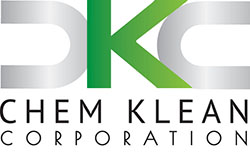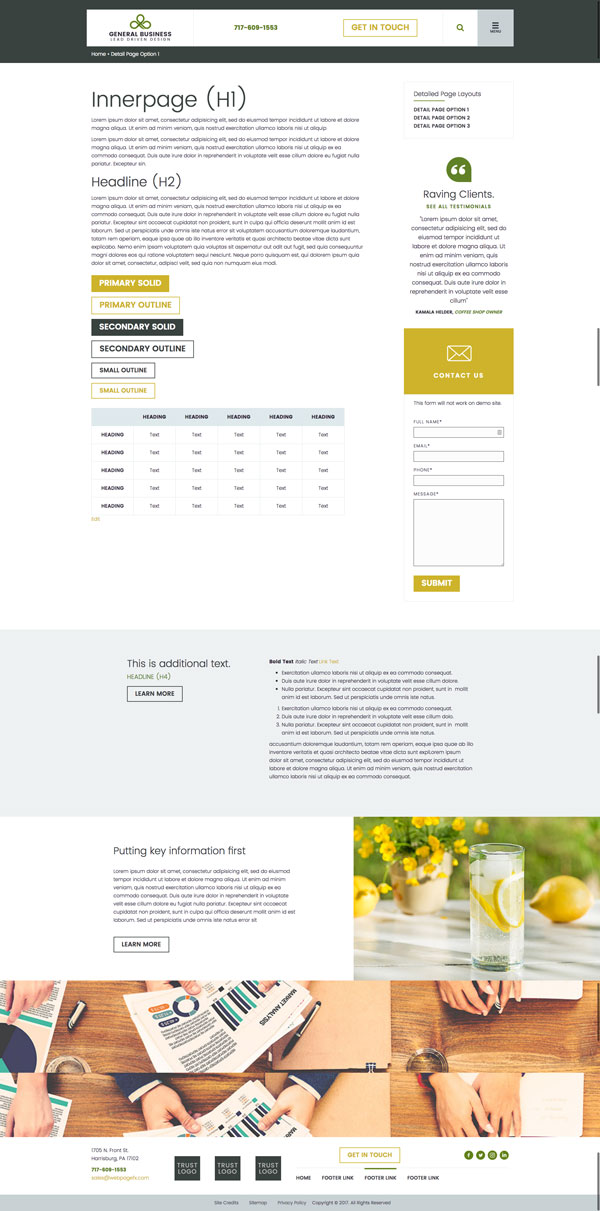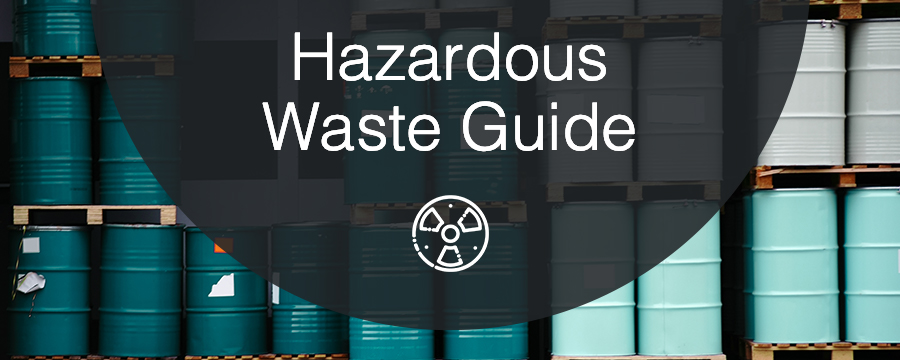
When you're looking into waste disposal methods, it's often helpful to have a waste guide for small businesses and other generators of hazardous waste. The hazardous waste disposal guide below will discuss hazardous waste in detail, explain the federal regulations governing different categories of hazardous waste generators and offer advice on choosing a reliable waste transportation company.
What Is Hazardous Waste?
Hazardous waste is any waste that can cause significant harm to human health or the environment. The U.S. Environmental Protection Agency (EPA) maintains a list of regulations that generators and transporters must comply with to ensure safety, health and cleanliness for the environment and our citizens.
Identification of Hazardous Waste
When your business seeks to identify hazardous waste, it's often helpful to ask questions like these:
1. Is the Material a Solid Waste?
The first question to ask yourself is whether the material is a solid waste. Even if they have toxic properties, some nonsolid materials fall outside the scope of regulation under the EPA's guidelines.
2. Is the Waste Excluded From the Definition of Hazardous Waste?
Some wastes, though potentially hazardous, do not fall under the definition of hazardous waste. For instance, most radioactive waste does not receive regulation as hazardous waste. Because of radioactive waste's distinctive properties and dangers, a different set of specific regulations governs its disposal.
3. Is the Waste a Listed or Characteristic Hazardous Waste?
To aid in regulation, the EPA maintains lists of specific, named hazardous wastes and wastes classified as hazardous because of certain characteristics.
Listed Wastes
The listed wastes appear on the EPA's lists F, K, P and U.
The extensive F and K lists include wastes from common industrial and manufacturing processes. They include materials such as these:
- Spent solvent wastes
- Electroplating wastes
- Wastes from petroleum refining
- Wastes from chemicals manufacturing
- Wastes from explosives manufacturing
The extensive P and U lists include various formulations of unused waste chemicals like these:
- Allyl alcohol
- Benzene
- Cyanides
- Fluorine
- Methoxychlor
- Thallic oxide
- Characteristic Wastes
The characteristic wastes may have one of four different properties:
- Corrosivity: These wastes typically have extremely high or low pH and can eat through steel.
- Ignitability: These wastes may be liquids with low flash points, ignitable compressed gases or nonliquids that can cause fires.
- Reactivity: Reactive wastes are often unstable under standard conditions, react with water, give off toxic gases or cause explosions when they become heated.
- Toxicity: Toxic wastes can cause bodily harm when absorbed or ingested.
4. Is the Waste Delisted?
In the classification of hazardous waste, it's also essential to check whether the waste remains listed or has become delisted. It's possible that the waste in question appeared on the EPA's official hazardous waste lists at one time but has since been delisted at a facility's request. In that case, the waste is not subject to regulation as hazardous waste.
Examples of Hazardous Waste
What are some examples of hazardous waste? Below are a few common ones:
- Solid waste: Solid waste may take a tremendous range of forms — some common examples include mercury-containing batteries, fluorescent light bulbs, wood preserved with creosote, paint booth filters and spent rags from painting or staining.
- Liquid waste: Hazardous liquid waste may take the form of flammable liquids like paints and solvents and corrosive fluids like acids, as well as oxidizers, poisons and many other hazardous products.
- Chemical waste: Some waste is hazardous because of its chemical content. Hazardous chemical products like many pesticides, solvents and reagents are examples of chemical waste.
- Spent oil: Numerous commercial and industrial processes generate waste oil as a byproduct. Spent oil is a hazardous waste and must undergo the same stringent disposal process as other hazardous wastes.
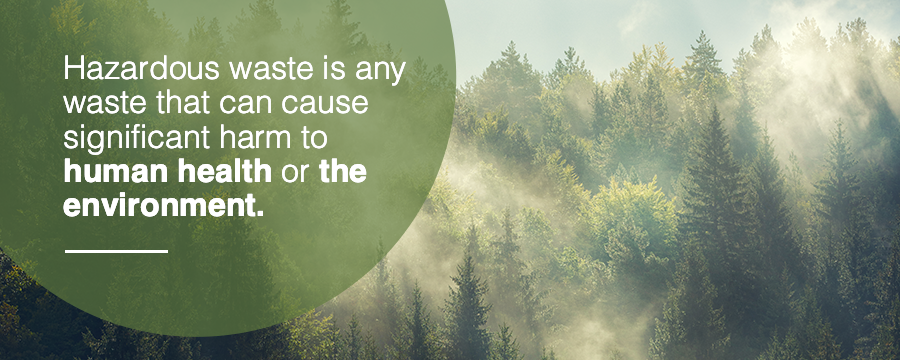
EPA's Cradle-to-Grave Hazardous Waste Management Program
In the management of hazardous waste, the Resource Conservation and Recovery Act (RCRA) of 1976 gives the EPA the authority to hold commercial and industrial waste generators responsible for their waste "from the cradle to the grave."
What Is The EPA's Cradle-to-Grave Waste Management Program?
The requirement for the EPA's cradle-to-grave concept in hazardous waste management means waste generators are responsible for their waste for its entire life span — that is, from the creation of the waste to its storage, transport and ultimate disposal or treatment.
Practically speaking, this provision means waste generators are liable for their waste at every step. If leaks and spills occur, the responsible company will likely receive fines or other penalties. The EPA is working toward new standards for the cradle-to-grave concept in hazardous waste management.
Resource Conservation and Recovery Act (RCRA)
What is the piece of legislation that gives the EPA cradle-to-grave hazardous waste regulation authority?
Congress passed the RCRA in 1976. The RCRA sets out a framework for managing hazardous and non-hazardous waste, and it gives the EPA its authority for cradle-to-grave management. It sets forth the hazardous waste management guidelines that waste generators and transporters must abide by. It has received a few amendments since its passage in 1976 to add requirements, strengthen enforcement measures and allow for regulatory flexibility in certain cases.
Regulations for Hazardous Waste Generators
What are the categories of hazardous waste generators defined under the EPA? And what are some of the federal hazardous waste management regulations in place for hazardous waste generators? Read below to learn more.
Categories of Hazardous Waste Generators
Below are the EPA's three defined categories of hazardous waste generators.
1. Very-Small-Quantity Generators
Very-small-quantity generators (VSQGs) are businesses that produce either
- 220 pounds or fewer of hazardous waste a month OR
- 2.2 pounds or fewer of acutely hazardous waste a month OR
- 220 pounds or fewer of acute spill residue or soil a month.
Some of the EPA's requirements for very-small-quantity generators include the following:
- VSQGs must identify all the hazardous waste they generate.
- VSQGs must limit their waste accumulation to 1,000 pounds or fewer of hazardous waste at any time.
- VSQGs must ensure the delivery of their hazardous waste to an individual or facility authorized to manage it.
2. Small-Quantity Generators
Small-quantity generators (SQGs) produce more than 220 pounds but less than 2,204 pounds of hazardous waste a month.
Below are some of the EPA's primary requirements for small-quantity generators:
- SQGs must not keep hazardous waste on their sites for more than 180 days without a permit. They may, however, accumulate waste for up to 270 days if they intend to ship it more than 200 miles.
- SQGs must not accumulate more than 13,227 pounds of on-site hazardous waste at a time.
- SQGs must comply with the relevant hazardous waste manifest requirements and pre-transport guidelines found in the Code of Federal Regulations (CFR).
- SQGs must also comply with relevant CFR preparedness and prevention requirements as well as all applicable land disposal regulations.
- SQGs must always have at least one employee available to act as an emergency coordinator and direct emergency response efforts. SQGs are not, however, required to maintain elaborate written emergency plans.
3. Large-Quantity Generators
Large-quantity generators (LQGs) produce either:
- 2,204 pounds or more of hazardous waste a month OR
- More than 2.2 pounds of acutely hazardous waste a month OR
- More than 220 pounds of acute spill residue or soil a month.
Below are some of the primary EPA requirements for large-quantity generators:
- LQGs must not keep waste for more than 90 days. Some exceptions to this rule may apply, however.
- LQGs may accumulate hazardous waste on-site without a weight limit.
- LQGs must manage their waste in the appropriate containers, containment buildings, drip pads or tanks. In doing so, they must adhere to all relevant CFR requirements.
- LQGs must comply with all applicable CFR hazardous waste manifest requirements and all pre-transport guidelines.
- LQGs must additionally comply with all relevant CFR prevention, preparedness and emergency procedure requirements, as well as all applicable land disposal restriction conditions.
- LQGs must submit a hazardous waste report every two years. This report, the National Biennial RCRA Hazardous Waste Report, covers the nature, quantities and disposal of all hazardous waste produced at the facility.
Recent changes to generator guidelines delivered some flexibility for waste generators. Under the new regulations, a generator no longer needs to upgrade to a higher category for temporary increases in hazardous waste creation. Generators must still follow all provisions of the rules for their current classification level.
The changes also allow companies that qualify as VSQG to transport their waste to an LQG, provided it remains under one person's control throughout the process.
Regulations for Hazardous Waste Transportation
Thus far, we have primarily discussed the requirements for storing hazardous waste. Additional regulations govern hazardous waste transport.
The EPA classifies hazardous waste transporters as any individuals who perform off-site transportation services for hazardous waste within the United States. Off-site transportation generally refers to shipment to another facility for storage, treatment or disposal rather than transportation within a single property or adjacent properties.
Below are some of the main requirements for hazardous waste transporters:
1. Procuring an EPA Identification Number
LQGs and SQGs must obtain EPA ID numbers, though VSQGs are exempt from this requirement.
An EPA ID number gives the EPA a reliable way to track hazardous waste transporters. Unless it is exempt, a company cannot transport hazardous waste without one of these numbers. The number identifies the company as a whole, so numerous trucks may use the same ID number if they belong to the same transportation fleet.
2. Utilizing the Hazardous Waste Manifest System
All hazardous waste transporters must comply with the EPA's hazardous waste manifest system. The EPA requires generators to fill out a hazardous waste manifest for every shipment of waste, and the manifest must accompany the cargo at all times. Each designated transporter or facility must sign and date the manifest and keep a copy on file for three years.
3. Responding to Hazardous Waste Discharges
Hazardous waste transporters must have effective protocols for responding to discharges immediately. These actions may include cleaning up the area until it no longer poses an environmental or health threat, diking the area or notifying the appropriate local authorities of the discharge.
A serious spill or accident requires the transporter to call and notify the National Response Center (NRC). The U.S. Department of Transportation (DOT) may also require the transporter to file a written incident report.
4. Complying With DOT Hazardous Materials Regulations
All transporters must comply with the applicable U.S. DOT hazardous materials regulations, including the requirements for activities like these:
- Labeling
- Marking
- Placarding
- Handling containers
- Responding to spills as outlined above
5. Utilizing Transfer Facilities
At some point along the route, a transporter may need to leave the waste overnight or for several days. A transporter may hold waste in a transfer facility — including spaces like parking lots, loading docks and storage areas — for up to 10 days without a permit. If the waste remains at the facility for longer than 10 days, the facility becomes a storage facility and is subject to all applicable regulations.
Hazardous Waste Recycling
Recycling hazardous waste, or at least some of its components, is often possible. For instance, hazardous waste sometimes contains metal components with high value for reuse in other products or processes. Facilities may also be able to regenerate substances like spent solvents. Proper hazardous waste recycling helps reduce pollution, decrease raw materials consumption, minimize energy use and lower the volume of waste that requires disposal.
The EPA maintains a set of hazardous waste recycling guidelines to protect human health and the environment. The applicable guidelines will depend on whether the material is subject to RCRA hazardous waste regulation.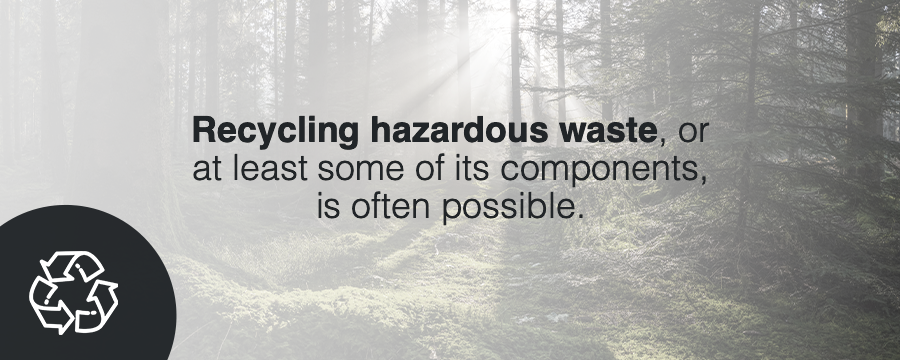
Materials With Alternative Management Standards
For certain recyclable hazardous materials, the EPA has developed alternative management standards to encourage recycling of these materials. Some of those materials include the following:
- Materials used for recovering precious metals
- Recyclable materials used in a manner equivalent to disposal
- Reclaimed lead-acid batteries
- Universal waste
- Used oil
- Waste burned in industrial furnaces and boilers
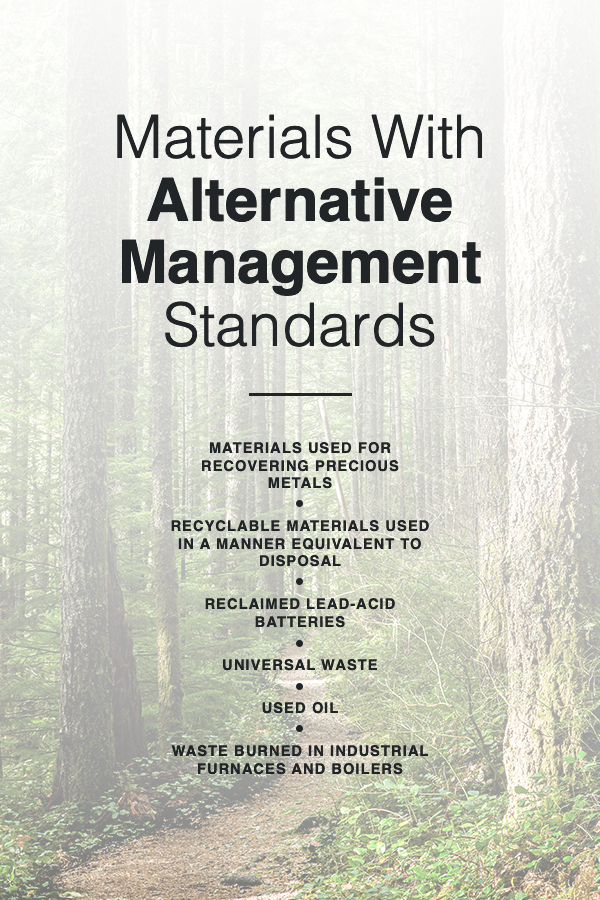
The EPA is encouraging the addition of aerosol cans to its list of universal wastes. This rule helps many in the retail sector and municipal governments adopt more recycling methods, keeping cans from landfills and incinerators. The revised guidelines still require appropriate labeling during storage and processing by a qualified facility.
In addition, certain exemptions exist for radiological and pharmaceutical waste as well as academic laboratory waste. Any other hazardous material falls under the full umbrella of hazardous waste management rules, even if recyclable.
Hazardous Waste Treatment
Hazardous waste must often undergo treatment before land disposal. The treatment removes contaminants and makes the waste less harmful so it will not pose a threat to human health or the environment if it leaks into the soil or groundwater.
The requirements for hazardous waste treatment depend on whether the waste is a listed or characteristic waste. For some hazardous wastes, such as debris, soil, lab packs and residues, the EPA has established alternative treatment standards that make treatment goals more achievable for most generators and cleanup projects.
Hazardous Waste Storage and Disposal Methods
Improperly disposing of hazardous waste threatens habitats and human life by destroying ecosystems, causing health problems, and creating unsafe environments more prone to fire or other safety risks. Safe, organized hazardous waste management creates a safer work environment and encourages more sustainable practices for your facility.
Hazardous waste must be carefully managed throughout the entire "cradle-to-grave" process, including the following:
- How your facility generates the waste.
- How your facility transports hazardous waste to treatment or disposal centers.
- Which hazardous waste disposal methods are used.
- Proper hazardous waste treatment, when necessary.
One method of saving hazardous waste disposal for laboratories and facilities across industries is lab packing services. No matter what method is chosen, it must comply with the RCRA hazardous waste disposal guidelines.
Choosing a Hazardous Waste Transportation Company
Now that you've read our guide to managing hazardous waste, you're in an excellent position to make an informed decision about your waste transportation company.
As you choose a company for industrial waste removal or to help you respond to an emergency, look for a business with extensive experience in handling the types of waste your facility produces. You should also glean as much detail as you can about the company's practices. Ensure that they are responsible, sustainable, dependable and can keep you in compliance with the applicable local and federal regulations.
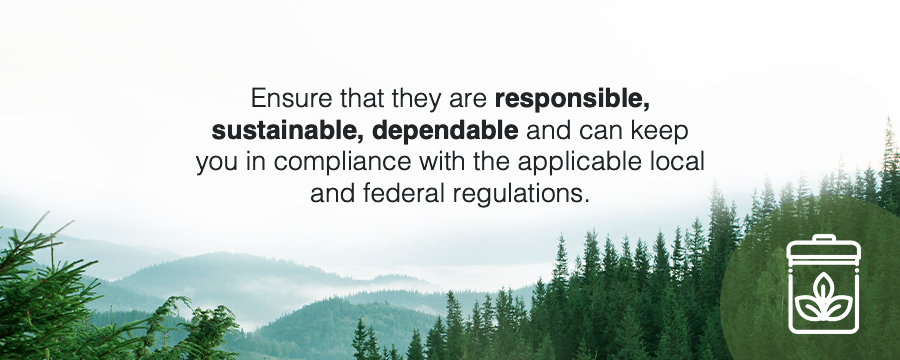
Dependable Waste Disposal Services From Chem Klean
At Chem Klean, we will be honored to be your choice for hazardous waste disposal. With more than 20 years of experience in the hazardous waste industry, we have the knowledge and industry expertise to help you meet your waste management goals. We offer a quick turnaround time, friendly service and cost-effective solutions that help you dispose of waste quickly at a price that fits your budget. Our approachable, trustworthy professionals are happy to consult with you about the best waste management plan for your business. Areas we serve include Miami-Dade County, Broward County, and more.
Contact us today to schedule hazardous waste transportation and keep pressing toward a cleaner tomorrow.
